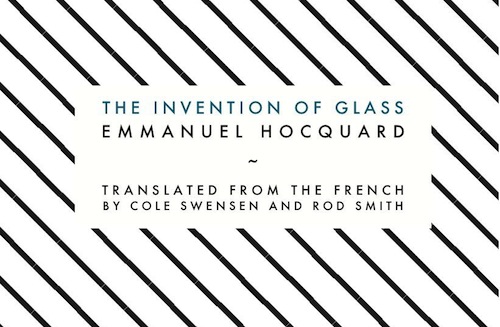'There is an abyss': Emmanuel Hocquard's The Invention of Glass

At Constant Critic, Karla Kelsey reviews Emmanual Hocquard's The Invention of Glass (translated by Cole Swensen and Rod Smith, Canarium Books 2012). Kelsey is as direct as Hocquard, it seems: "Within and against the opacities of the abyss structure and naming order and clarify. Transparent aspects of The Invention of Glass are due in large part to Hocquard’s elegant and simple structure. The book has three distinct sections with straightforward names: “Poem,” “Story,” “Notes.” It is mainly in virtue of the structural, formal, and tonal similarities within each section that the book has transparency and can be held onto intellectually." Kelsey looks closely at each section. The first:
The first third of the book, “Poem,” is a series of 20 numbered sections and, although each section creates the feeling of an autonomous poem, the series works as a continuous whole. Uniform in form and style, each section is headed by a number (1-20), begins with an italicized phrase, and unfolds in a single stanza of 48 lines long. Each line is roughly between 5 and 10 syllables long; the poem’s sentences are grammatical and relatively short (except for section 11, which is one long sentence) and enjamb, creating a fairly tight path down the page. The tone throughout is meditative, asking questions and pursuing ideas. But this surface is not smooth and rhetorical: Hocquard leaps from subject to subject without supplying overt connections. Particular details balance abstract concepts to address such themes as coming into being, the textures of the material world, and the nature of naming. These themes rise to the surface and come back across the series. Section 7, which of all of the sections most overtly treats of the theme of glass, serves as an example of the way “Poem” feels. It begins like so:
There is glass. The respite sheds light on the passage. A broken branch across the path. How to see this pink cloth? It’s right. Prisoner of his perspective the commander missed everything. Ancient walls become paths. Affirming and negating can be equally energizing. Why these forms?
But "Poems," "Story," and "Notes" are drawn together:
The third section of the book, “Notes,” only runs from pages 115-117. Although “Notes” consists only of citations corresponding to the quoted material in “Story” (and to the book’s two epigraphs, taken from Keith and Rosmarie Waldrop), Hocquard gives it equal status with the rest of the book by using the same bold, sans-serif titling as “Poems” and “Story” and by listing it in the Table of Contents just as they are. Hocquard’s inclusion of notes provides a generous transparency of source. And his elevation of notes to the same status as “Poem” and “Story” implies a map for how a poem is made with and through a writer’s engagement with novels, poetry, criticism, history and philosophy. Here again we have transparency and opacity: “Notes” renders the process transparent, but, it is essential to note, the mystery that brings a poem into being out of a source text remains an opacity. Tracing section 7 from “Poem” to “Story” to “Notes” and back again provides the gesture or outline of composition, and provides material for creative reading, but does not answer the more intense questions of creative mystery.
Read the full review at Constant Critic.


